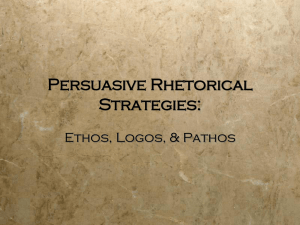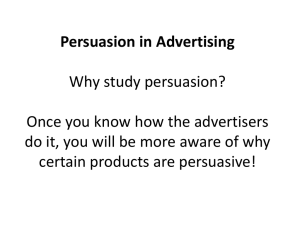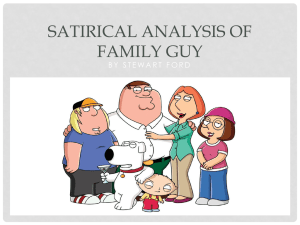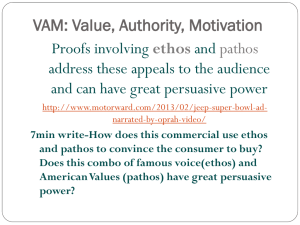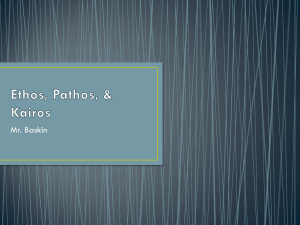logos_ethos_pathos_e32007
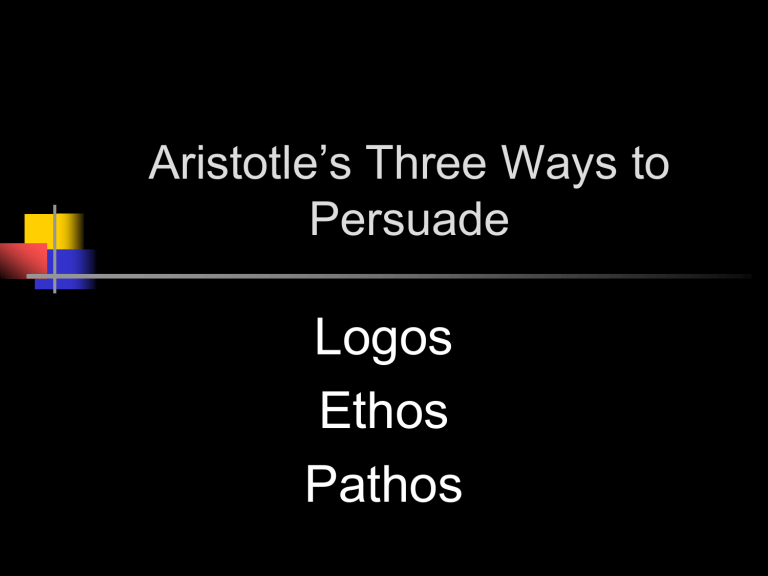
Aristotle’s Three Ways to
Persuade
Logos
Ethos
Pathos
Who is Aristotle?
Aristotle (384-322 BCE) is the most notable product of the educational program devised by Plato. Aristotle wrote on an amazing range of subjects, from logic, philosophy, and ethics to physics, biology, psychology, politics, and rhetoric.
What is rhetoric?
Rhetoric is the art of persuasion .
The goal of persuasion is to change others’ point of view or to move others to take action.
What is logos, ethos, and pathos?
Logos = Logic
Ethos = Ethics, Image
Pathos = Emotions (Passion)
Logos, Ethos, Pathos
Using logos, ethos, and pathos will help you to master the art of persuasion .
• Through language, you will be able to change the point of view of others!
• Through language, you will be able to motivate others to take action!
Logos
Logos is an argument based on facts, evidence and reason.
Using logos means appealing to the readers’ sense of what is logical.
Ethos
Ethos is an argument based on character.
Using ethos means the writer or speaker appeals to the audience’s sense of ethical behavior. The writer or speaker presents him or herself to the audience as credible, trustworthy, honest and ethical.
“I am an ethical expert, so believe what I say.”
Pathos
Pathos = argument based on feelings
Using pathos means appealing to readers’ emotions and feelings.
Symbols for Logos,
Ethos and Pathos
Logos = Head
Ethos = Hand
Pathos = Heart
Logos
Logos
Ethos
Ethos
Ethos
Ethos
Pathos
Pathos
Pathos
Logos Example
In the following example, note how Ian Ayres uses evidence from experience (her work environment, Delta Airlines, the University of Chicago). This evidence establishes the precedent that Ayres uses to compare to the current situation that she argues should be changed.
Logos Example
We don’t have single-sex toilets at home, and we don’t need them at the office. Then there’s also the small question of efficiency. I see my male colleagues waiting in line to use the men’s room, when the women’s toilet is unoccupied. Which is precisely why Delta Airlines doesn’t label those two bathrooms at the back of the plane as being solely for men and women. It just wouldn’t fly.
Logos Example
The University of Chicago just got the 10 single-use restrooms on campus designated gender neutral.
It’s time Yale followed suit. And this is not just an academic problem. There are tens of thousands of single-use toilets at workplaces and public spaces throughout the nation that are wrongheadedly designated for a single-sex. All these single-use toilets should stop discriminating. They should be open to all on a first-come, first-lock basis.
—Ian Ayres, “Looking Out for No. 2”
Ethos Example
In the following example, note how Nancy
Mairs establishes her credibility and trustworthiness and authority to write about this subject by being honest . Mairs admits she is uncertain about her own motives and shows she understands the discomfort others’ have with this subject.
Ethos Example
First, the matter of semantics. I am a cripple. I choose this word to name me. I choose from among several possibilities, the most common of which are “handicapped” and “disabled.” I made the choice a number of years ago, without thinking, unaware of my motives for doing so.
Even now, I am not sure what those motives are, but I recognize that they are complex and not entirely flattering.
Ethos Examples
People —crippled or not—wince at the word
“cripple,” as they do not at “handicapped” or
“disabled.” Perhaps I want them to wince. I want them to see me as a tough customer, one to whom the fates/gods/viruses have not been kind, but who can face the brutal truth of her existence squarely. As a cripple, I swagger.
—Nancy Mairs, “On Being a Cripple”
Pathos Example
In the following example from a speech by
Winston Churchill, note the use of anaphora (repetition of a word or group of words at the beginning of items in a series).
This repetition emphasizes the point and expresses passion and emotion.
Moreover, the repetition affects the audience emotionally.
Pathos Example
We shall not flag or fail. We shall go on to the end. We shall fight in France, we shall fight on the seas and oceans, we shall fight with growing confidence and growing strength in the air, we shall defend our island, whatever the cost may be, we shall fight on the beaches, we shall fight on the landing grounds, we shall fight in the fields and in the streets, we shall fight in the hills. We shall never surrender.
—Winston Churchill, speech to the House of
Commons, June 4, 1940
Review
Logos = logic
Logos is an argument based on facts, evidence and reason.
Using logos means appealing to the readers’ sense of what is logical.
Review
Ethos = Ethics / Image
Ethos is an argument based on character.
The writer or speaker presents him or herself to the reader as credible, trustworthy, honest and ethical.
Review
Pathos = argument based on feelings
Using pathos means appealing to readers’ emotions and feelings.

